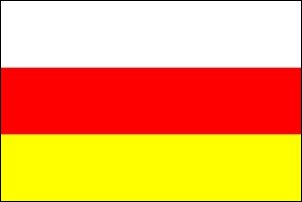
OSSETIA
The Ossetians are descended from the Alans, a Sarmatian tribe inhabiting the foothills of the Caucasus in the 4th c. They were pushed further back into the mountain gorges by Tatar and Mongol forces. Ossetians who remained on the north slope of the Caucasus range, lived in perpetual conflict with the Kabards, who came to convert the Digor Ossets to Islam. Ossetians who migrated to the south slope have retained their language and culture in medieval and modern Georgia.
During the reign of Catherine II, Russian imperial expansion reached the Caucasus. In 1774, North Ossetia was absorbed into Russia. Russian policy has always been to exploit the ethnic rivalries among the region's peoples.
North Ossetia's economy was transformed by industrialisation and urbanisation in th 19th c., because of its reserves of natural resources (Zinc, lead, natural gas). The railroad from the oil boomtown of Baku passed through Ossetia, and a branch line reached Vladikavkaz, today the capital of North Ossetia.
During the Civil War years after the 1917 revolution, there was fighting in Ossetia between Bolsheviks, Mensheviks and counter-revolutionary armies under Gen. Anton Denikin. In 1922, a South Ossetian Autonomus Oblast (AO), was carved out of Georgia, whereas a North Ossetian AO was created within Russia in 1924 as the failed "Autonomous Mountain Soviet Socialist Republic" was split up. In 1925, North and South Ossetia made efforts to unite, signing a petition to Stalin.
The Bolshevik policy in Ossetia had a main goal of eliminating clan warfare and other "feudal practices", and were moderately successful. But still, in the 1930s, Ossetians used Stalin's purges to carry on old vendettas.
In 1936, North Ossetia was upgraded to Autonomous Republic, which in fact had no meaning during Stalin's dictatorship.
The Ossetians were loyal to the Soviet Union during World War 2, when the Germans pressed to reach the oil fields of Baku and Groznyy. After the war they were rewarded in that their republic was enlarged at the expense of the Chechen-Ingush ASSR and Stavropol kray. The Muslim Digor Ossets, however, were deported to Central Asia, where some of them remain even today.
In 1989, in the freedom of glasnost and perestroyka and frightened by rising Georgian nationalism, the South Ossetians demanded unification with North Ossetia. In December the next year, the Georgian Supreme Soviet declared that South Ossetia was no longer autonomous and authorised suppression of newspapers and bans on demonstrations. One issue at stake was the language. Georgian was declared as official language. The Ossetians declared Ossetian as the official language of South-Ossetia. Fighting commenced in January 1991. The conflict worsened with the Georgian independence declaration in March and the election of the nationalist authoritarian poet-President Zviad Gamsakhurdia some months later. A flood of refugees left for North Ossetia. The Ossetians are also involved in a conflict with the Ingush, their neighbours to the east.
Source: Norwegian Institute of International Affairs [NUPI] - Centre for Russian Studies
Back to Caucasus main page
|
